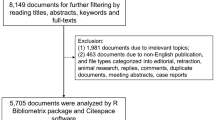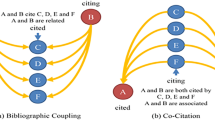Abstract
Introduction and hypothesis
The association between social media (SoMe) indicators and citation metrics is still controversial. we aimed to evaluate the frequency of urogynecology-related terms (“urogynecology” [UG] and “pelvic floor/dysfunction” [PF/PFD]) mentioned by traditional databases (Web of Science [WOS]) and journal ranking indicators (SCImago), as well as their association with SoMe (Altmetric database).
Methods
In April 2019, two authors performed a search that was divided into three steps. The first one was to assess journals within the WOS Obstetrics/Gynecology and Urology categories updated to 2017 using UG and PF/PFD. The second step was to rank these studies in SCImago by the highest numbers of WOS and to correlate with journal h-index and SJR. The third step was to analyze SoMe indicators such as the Altmetric Attention Score (AAS) for each study and journal retrieved.
Results
The International Urogynecology Journal (IUJ) and Neurourology and Urodynamics (NAU) were the first (n = 1,394) and second (n = 974) most highly cited journals when using UG and PFD. IUJ also presented manuscripts with the highest AAS for UG and PF/PFD. Social media represented 74–93% of AAS calculated among the 20 top cited studies. For UG, SoMe presented 8,050 mentions, led by Twitter (n = 7,326). The same distribution was seen for PFD (8,493 mentions for SoMe, Twitter with 7,653). The higher the WOS citation, the higher the AAS (r = 0.483; p = 0.03).
Conclusion
UG and PF/PFD terms are highly cited in databases and IUJ was the journal most frequently connected with them. Among SoMe tools, Twitter was the most frequently cited. WOS citations correlated with AAS.



Similar content being viewed by others
References
Mclennan MT, Leong FC, Steele AC, Harris JK. The influence of national society annual scientific meetings on publication in general obstetrics and gynecology literature: a urogynecology perspective. Int Urogynecol J Pelvic Floor Dysfunct. 2009;20(12):1463–7.
Garfield E. 100 citation classics from the journal of the American Medical Association. JAMA. 1987;257(1):52–9.
Trueger NS, Thoma B, Hsu CH, Sullivan D, Peters L, Lin M. The altmetric score: a new measure for article-level dissemination and impact. Ann Emerg Med. 2015;66:549–53.
Bornmann L, Haunschild R. Do altmetrics correlate with the quality of papers? A large-scale empirical study based on F1000Prime data. PLoS One. 2018;13(5):e097133.
Chandrasekar T, Goldberg H, Klaassen Z, Wallis CJ, Leong JY, Liem S, et al. Twitter and academic urology in the United States and Canada: a comprehensive assessment of the Twitterverse in 2019. BJU Int. 2020;125:173–81.
Gupta A, Kennedy B, Meriwether K, Francis SL, Cardenas-Trowers O, Ryan Stewart J. Citation classics: the 100 most cited articles in urogyneccology. Int Urogynecol J. 2020;31:249–66.
SJR—SCImago Journal & Country Rank [Portal]. http://www.scimagojr.com. Accessed March 2019
2017 Journal Impact Factor, Journal Citation Reports Science Edition (Clarivate Analytics, 2018).
Altmetric. Altmetric database in JSON format: unpublished raw data; 2019.
Fleiss JL, Levin B, Paik MC. Statistical methods for rates and proportions. New York: Wiley; 2013.
Abrams P, Cardozo L, Fall M, Grisffiths D, Rosier P, Ulmsten U, et al. The standardization of terminology of lower urinary tract function: report from the standardisation sub-committee of the International Continence Society. Neurourol Urodyn. 2002;21(2):167–78.
Jeong JW, Kim MJ, Oh HK, et al. The impact of social media on citation rates in coloproctology. Colorectal Dis. 2019;21:1175–82.
Hayon S, Tripathi H, Stormont IM, Dunne MM, Naslund MJ, Siddiqui MM. Twitter mentions and academic citations in the urologic literature. Urology. 2019;123:28–33.
Ladeiras-Lopes R, Clarke S, Vidal-Perez R, Alexander M, Luscher TF; ESC (European Society of Cardiology) Media Committee and European Heart Journal. Twitter promotion predicts citation rates of cardiovascular articles: a preliminary analysis from the ESC Journals Randomized Study. Eur Heart J.2020;doi: https://doi.org/10.1093/eurheartj/ehaa211.
Jallad K, Iglesia CB. Why urogynecologists need to be on social media. Female Pelvic Med Reconstr Surg. 2020;26(5):281–2.
Brito LG. Is social media really impacting urogynecology? Int Urogynecol J. 2020. https://doi.org/10.1007/s00192-020-04361-x.
Acknowledgements
The authors would like to thank Altmetric LLP for providing this study’s data free of charge with the goal of research/publication.
Funding
Coordenação de Aperfeiçoamento de Nível Superior, code 001.
Author information
Authors and Affiliations
Contributions
L.G.O. Brito: project development, data analysis, manuscript writing/editing; G.M.V. Pereira: project development, data collection, manuscript writing/editing; S.C. Rocha: data collection, manuscript editing; H.d.C. Machado: data analysis, manuscript editing.
Corresponding author
Ethics declarations
Conflicts of interests
None.
Additional information
Publisher’s note
Springer Nature remains neutral with regard to jurisdictional claims in published maps and institutional affiliations.
Rights and permissions
About this article
Cite this article
Pereira, G.M.V., Rocha, S.C., da Costa Machado, H. et al. How do urogynecology and pelvic floor dysfunction terms used in female pelvic medicine and reconstructive surgery research relate to social media indicators?. Int Urogynecol J 32, 1143–1149 (2021). https://doi.org/10.1007/s00192-020-04438-7
Received:
Accepted:
Published:
Issue Date:
DOI: https://doi.org/10.1007/s00192-020-04438-7




